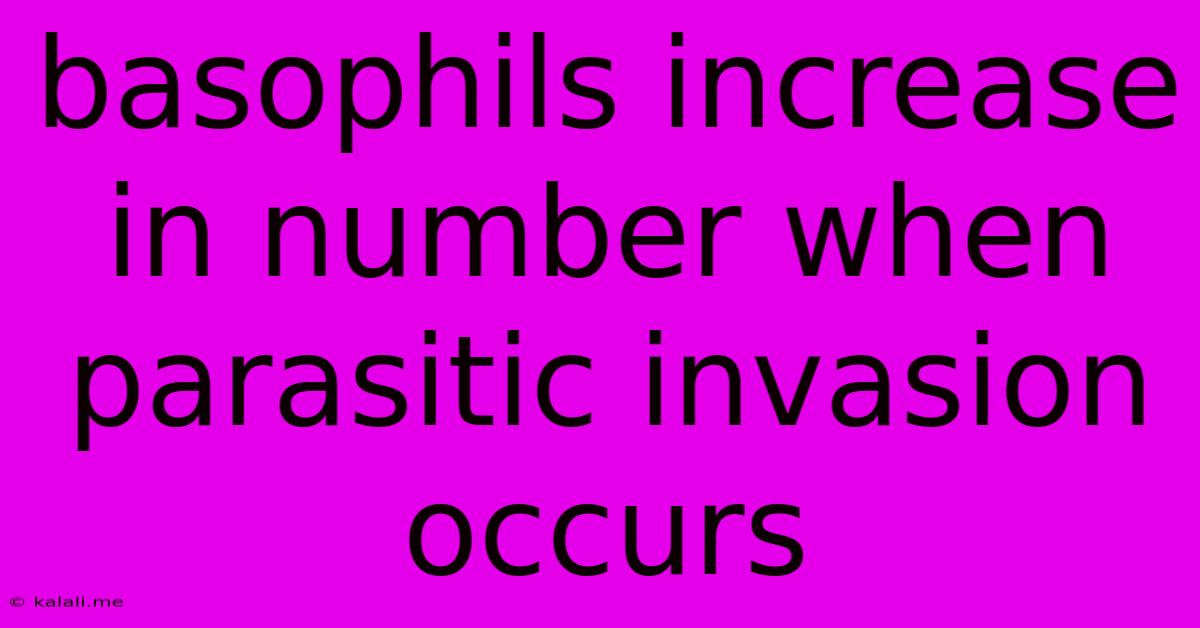Basophils Increase In Number When Parasitic Invasion Occurs
Kalali
May 10, 2025 · 3 min read

Table of Contents
Basophils: The Unsung Heroes of Parasitic Invasion
Basophils, those often-overlooked components of our immune system, play a crucial, albeit often understated, role in defending against parasitic invasions. While their overall numbers in the blood are relatively low compared to other leukocytes, their presence significantly increases during parasitic infections, signaling an important immune response. This article will delve into the mechanisms behind this increase and the vital functions basophils perform in combating parasites.
Understanding Basophils and Their Role in Immunity
Basophils are a type of white blood cell, specifically a granulocyte, characterized by their large, dark-staining granules filled with histamine, heparin, and other inflammatory mediators. Unlike neutrophils and eosinophils, which are the primary effectors in bacterial and viral infections, basophils are more prominently involved in allergic reactions and parasitic infections. Their granules contain potent substances that contribute to both the inflammatory response and the elimination of parasites.
The Mechanism Behind Basophil Increase During Parasitic Infection
The increased number of basophils during a parasitic invasion is a complex process driven by several factors:
-
Cytokine Stimulation: Parasitic infections trigger the release of various cytokines, signaling molecules that act as messengers within the immune system. These cytokines, such as IL-3, IL-4, and GM-CSF, stimulate the bone marrow to increase basophil production and release them into the bloodstream. This is a key mechanism behind the observed basophilia (increased basophil count).
-
Chemokine Attraction: Once released, basophils are attracted to the site of infection by chemokines, another class of signaling molecules. These chemokines, produced by other immune cells at the infection site, guide basophils to where they are most needed to combat the parasite.
-
Antibody-Dependent Cell-Mediated Cytotoxicity (ADCC): Basophils, like other granulocytes, participate in ADCC. This process involves the binding of antibodies to the surface of parasites, which then allows basophils to recognize and destroy them through the release of their cytotoxic granules. This is particularly important in targeting larger parasites.
The Actions of Basophils Against Parasites
Basophils contribute to parasite elimination through several crucial mechanisms:
-
Histamine Release: Histamine, a key component of basophil granules, increases vascular permeability, allowing other immune cells and antibodies to access the infection site more easily. This enhanced access facilitates the destruction of parasites.
-
Heparin Release: Heparin, an anticoagulant, prevents blood clotting at the site of infection, ensuring that immune cells can continue to move freely and reach the parasites.
-
Release of other inflammatory mediators: Besides histamine and heparin, basophils release other potent inflammatory mediators like leukotrienes and prostaglandins which contribute to the inflammatory response and the elimination of parasites.
-
Antigen Presentation: Although less extensively studied, basophils can also act as antigen-presenting cells (APCs), presenting parasite antigens to other immune cells like T cells to activate and coordinate a more robust immune response.
Clinical Significance of Basophilia
Elevated basophil counts (basophilia) are often associated with parasitic infections, particularly helminthic infections (worms). While basophilia alone isn't diagnostic, it can be a valuable indicator, prompting further investigation and aiding in the diagnosis of parasitic infections. The level of basophilia often correlates with the severity and stage of the parasitic infection. Other factors contributing to basophilia include allergic reactions and certain blood disorders.
Conclusion
Basophils, although present in relatively small numbers, play a critical role in the immune response to parasitic invasions. Their increased numbers during infection reflect a vital part of the body's defense mechanisms. Further research into the precise mechanisms and interactions of basophils in parasitic infections is ongoing, promising a deeper understanding of their contribution to immune function and potential therapeutic applications. Understanding the role of basophils highlights the complexity and interconnectedness of our immune system in combating various pathogens.
Latest Posts
Latest Posts
-
What Is 20 Percent Of 800 000
Jul 12, 2025
-
Words That Start With Y In Science
Jul 12, 2025
-
Prevent An Expressway Emergency By Merging Without
Jul 12, 2025
-
How Many Grams Of Sugar In A Pound
Jul 12, 2025
-
7am To 11am Is How Many Hours
Jul 12, 2025
Related Post
Thank you for visiting our website which covers about Basophils Increase In Number When Parasitic Invasion Occurs . We hope the information provided has been useful to you. Feel free to contact us if you have any questions or need further assistance. See you next time and don't miss to bookmark.